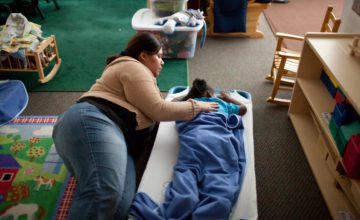America’s future depends on quality child care. It not only fuels our country’s economic engine by allowing parents to work, but also builds the workforce of the future.
America’s future depends on quality child care. It not only fuels our country’s economic engine by allowing parents to work, but also builds the workforce of the future. Of the 12 million infants and toddlers in the United States, more than half spend some or all of their day being cared for by someone other than their parents. Yet, the COVID-19 pandemic revealed a fragile, underfunded child care system that falls short of what babies and families need to thrive and our economy needs to stay strong. As we build back, policymakers must recognize child care as an essential public good and ensure all families who need it have quality, affordable, and accessible care that supports their babies’ healthy development.
Quality child care feeds a baby’s growing brain, building the foundation for them to thrive as adults. But available research shows that 75% of toddlers in center care and 93% in home-based care are in low or mediocre quality care settings that can be detrimental to their development. Despite research that shows that over-burdened and under-resourced children benefit most from quality child care, low quality care is often the only care available to them. In particular, children of color lack equitable access to quality formal early care and learning experiences. Because quality is so closely associated with the relationships that child care providers build with young children, support and training of the child care workforce is critical.
Affordable child care allows families to work without devouring earnings, but it is in short supply. While most young children are in families with fairly modest incomes, in 30 states and Washington, D.C., center-based child care for infants and toddlers is more expensive than in-state tuition and fees at a public university. Only 4.2% of low- and moderate-income infants and toddlers are served by the child care assistance available through the Child Care and Development Fund. Additionally, many families do not benefit from the current child care tax credit because they have little or no federal income tax liability and the maximum tax benefit does not approach the actual cost of infant-toddler care.
Accessible child care means families have the safe quality care they need in their communities, during the hours they need to work. As the nation copes with the long-term impacts of COVID-19, families will need a broad array of options to meet their child care needs to return to the workforce. COVID-19 exacerbated the stress on the child care system. Many providers have been forced to close, unable to make the economics of providing child care work, or have limited enrollment in the interest of public health, further narrowing access to the care that families need. Programs are coping with under-enrollment and slow growth due to smaller classes, and fewer children returning because of continued high unemployment or parents’ concerns about putting their children back in group settings.
As we build toward the future, Congress and the Administration must commit to creating a robust child care system that supports the development of all children. Doing so will not only support our economic recovery, but will ensure our future workforce – today’s babies and toddlers – arrive at school ready to learn and prepared for future success.
Quick Facts
- 6 million children under age 3 are in non-parental care.
- High quality child care improves:
- Cognitive and language development;
- Social and emotional development; and
- School achievement.
- In 30 states and Washington, D.C., center-based child care for infants and toddlers is more expensive than in-state tuition and fees at a public university.
- Only 4.2% of families with low or moderate income have access to child care assistance through the Child Care and Development Fund.
- Only 10% of child care programs nationwide are rated as high-quality.
- Overall, children of color live in neighborhoods with fewer high-quality child care options.
- 7 in 10 voters support increased Congressional funding for child care, including 2/3 of voters without children under the age of 18.
Policy Recommendations
As the child care system rebuilds following the COVID-19 crisis, we cannot go back to what it was. Robust public funding is imperative for a system of high-quality programs and providers that are accessible to all families. Any policy solution must be built on principles that will ensure it serves the needs of the current and future workforce:
- Quality — All children receive high-quality child care.
- Affordability — Families get the financial support they need to afford high-quality child care.
- Access — Families can access the high-quality child care setting that best meets their needs.
- Workforce — Early childhood professionals in all settings can receive the support, resources, and compensation they need to provide high-quality care and support their own families.
Research
Quality child care readies babies for success.
Children in the Abecedarian Project, which provided quality child care starting at birth, had long-lasting positive impacts that led to higher IQ and achievement test scores, fewer grade retentions and placements in special education, higher levels of college graduation and job-holding, and healthier outcomes as adults. For virtually every developmental outcome that has been assessed, quality of care also shows positive associations with early social and emotional development, leading to more competent peer relationships during early childhood and into the school years.
The quality of the relationship between the child care provider and child matters.
The quality of child care ultimately boils down to the relationship between the child care provider and the child; skilled and stable providers promote positive development. Caregivers and teachers should have specialized knowledge and skill in early childhood development, with a focus on infants and toddlers, as well as receive support and compensation that reflect the critical nature of the work they do – yet currently child care workers make just $11.42 per hour. To help children make connections that support their development, there should be a 1:4 caregiver to child ratio and no more than eight children per group. One primary, but not exclusive, caregiver for at least one year, and optimally until age three, is critical for an infant’s emotional development. Across the country, however, only 35 states require licensed providers to meet the recommended 1:4 staff-child ratio for infants, and even fewer states meet the minimum standard as children grow older. Only 12 states meet the standard for younger toddlers and only 2 states meet the standard for all children under age 3.
Children of color lack equitable access to affordable, high-quality child care.
Quality child care is important for all families with young children, with positive long-term impact, but it is especially beneficial for children from over-burdened and under-resourced families. On average, families of color are two to three times more likely to be affected by poverty than their white counterparts, making them less able to afford the high cost of infant and toddler child care, and more likely to live in economically disadvantaged communities that lack high-quality early care providers. Furthermore, Black and Latinx families are also more likely to work the nontraditional hours that make accessing high quality care particularly difficult.
Child care is crucial to getting families back to work, but COVID-19 has further threatened access to the quality, affordable child care they need.
Even before the COVID-19 pandemic, child care providers operated on razor thin profit margins. At the same time, families could scarcely afford care. In no state does the cost of center-based infant or toddler child care meet the federal definition of affordable—no more than 7 percent of annual household income. On average, a family making the state median income would have to spend 18 percent of their income to cover the cost of child care for an infant, and 13 percent for a toddler. The pandemic has increased the stress on this already fragile system. Programs are coping with under-enrollment and slow growth due to smaller classes, and fewer children are returning to care because of continued high unemployment or parental concerns about putting their children back in group settings. Families and providers alone cannot make up the difference.




